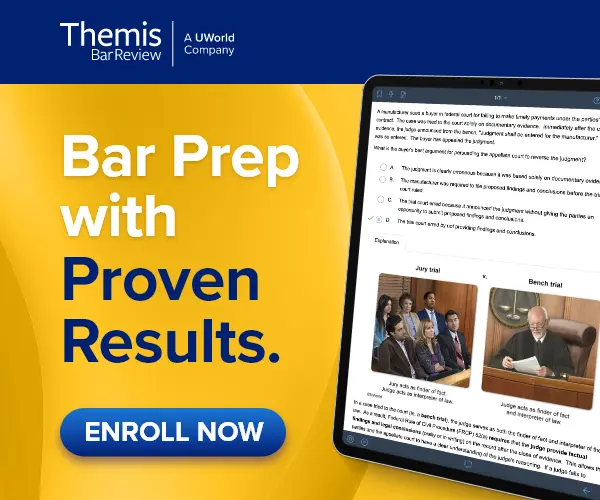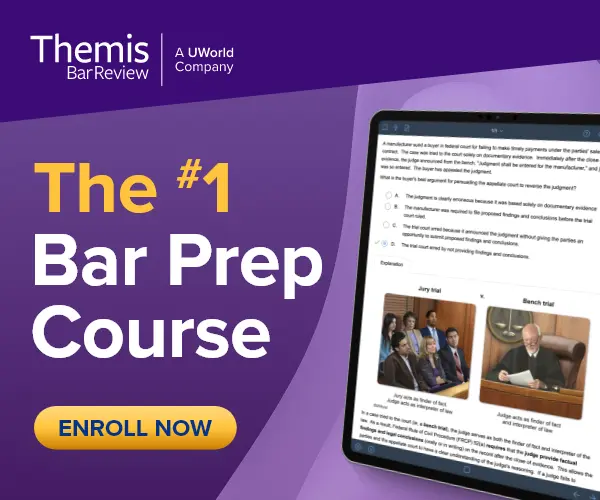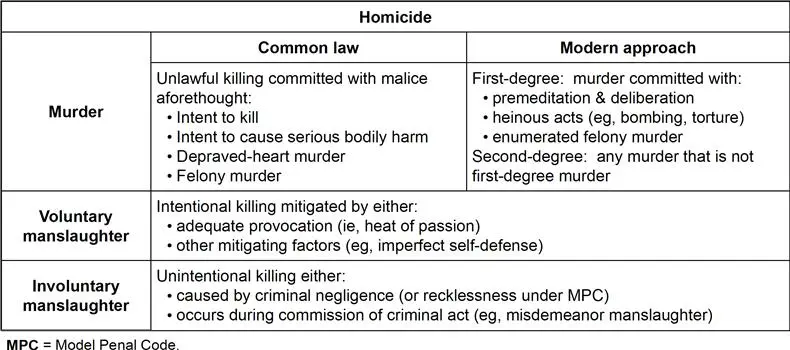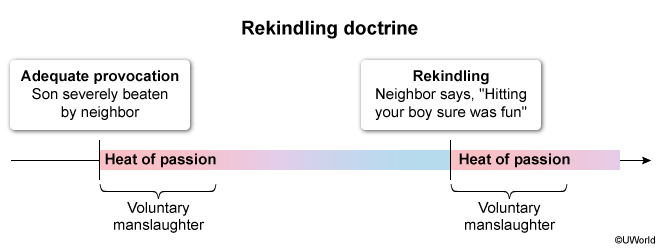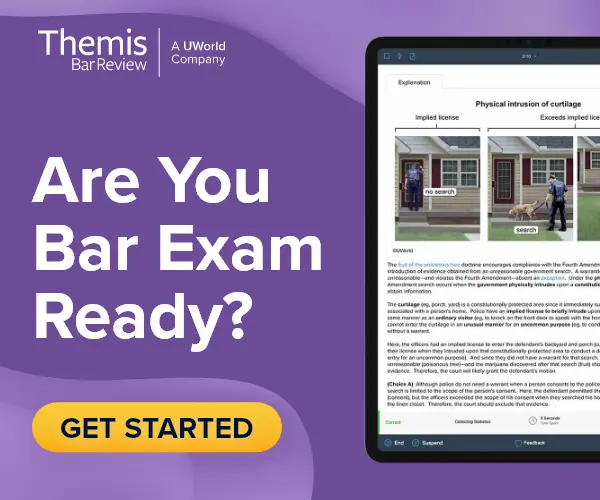On the MBE, you'll face 25 questions on Criminal Law and Procedure, typically evenly split. Criminal Law focuses on the elements of crimes — what makes up a crime, the required intent, and the various defenses such as self-defense or insanity. It covers crimes such as homicide, theft, and assault. Criminal Procedure centers around the rights of individuals throughout the criminal process — from police investigations and arrests to trials and appeals.
Although both subjects are closely related, they each have a unique set of principles. Grasping these differences will help you navigate MBE questions more effectively.
Criminal Law and Procedure Breakdown by Topic, Weightage and Tested Questions
The Criminal Law and Procedure section of the MBE is divided into 5 key categories, each with a different weightage:
| Constitutional Law Topics | % Tested | # of Questions |
|---|---|---|
| Homicide | 12.5% | 3-4 |
| Other crimes | 12.5% | 3-4 |
| Inchoate crimes; parties | 12.5% | 3-4 |
| General principles | 12.5% | 3-4 |
| Constitutional protection of accused persons | 50.0% | 12-13 |
| Total scored questions for Criminal Law & Procedure | 25 | |
The breakdown, as outlined by the National Conference of Bar Examiners (NCBE®), emphasizes the substantial weight given to Constitutional protections, which account for half of the Criminal Law and Procedure section. While this area requires focused attention, it is equally important to approach the other topics with a well-rounded strategy to ensure a comprehensive preparation.
Homicide
The Criminal Law and Procedure bar exam generally contains 3-4 homicide questions. Key areas to focus on:
- Intentional Killings: Premeditation and deliberation
- Unintentional Killings: Reckless behavior, negligence, and felony murder
- Manslaughter: Provocation and misdemeanor manslaughter
These questions often present fact patterns where you’ll need to assess the defendant’s actions and mental state to determine the appropriate charge. That’s why it is imperative to pay particular attention to the defendant’s intent and emotional state to identify the correct level of homicide.
Other Crimes
Homicide isn’t the only offense covered on the MBE. You can also expect to face Criminal Law bar exam questions about offenses such as:
- Theft and receiving stolen goods
- Robbery
- Burglary
- Assault and battery
- Rape; statutory rape
- Kidnapping
- Arson
- Possession offenses
As with the homicide portion of the exam, questions about these other crimes are usually posed in the form of sample cases. To answer them correctly, focus on the elements of the crime. If an element is missing, the defendant cannot be convicted of the offense.
Inchoate Crimes
Inchoate crimes are incomplete offenses. The MBE Criminal Law and Procedure section asks 3-4 questions about these offenses. Key topics to focus on include:
- Types of inchoate offenses
- Attempts
- Conspiracy
- Solicitation
- Parties to crime
When preparing to answer questions about inchoate offenses, remember the merger doctrine. It may impact the crimes the defendant can be convicted of.
General Principles
Similar to Homicide, Other Crimes, and Inchoate Crimes, you can expect 3-4 questions on the general principles of criminal law on the MBE. To tackle these effectively, you must have a strong grasp of foundational concepts, including:
- Acts and omissions
- State of mind: Required mental state, strict liability, and mistake of fact or law
- Responsibility: Mental disorder and intoxication
- Causation
- Justification and excuse
- Jurisdiction
To perform effectively in this section of the MBE, it's essential to clearly understand the differences between concepts such as intent and recklessness. Grasping how these concepts apply to different criminal offenses will help you accurately determine a defendant's mental state and apply the correct legal principles in each case. Make sure to review key terms, their definitions, and how they affect the outcome of various crimes.
Constitutional Protection of Accused Persons
Half of the Criminal Law and Procedure questions on the MBE are dedicated to the constitutional protections of accused persons, making this topic a critical area of focus during your preparation.
Key topics to prioritize include:
- Arrest, search, and seizure
- Confessions and the privilege against self-incrimination
- Lineups and identification procedures
- Right to counsel
- Fair trial and guilty pleas
- Double jeopardy
- Cruel and unusual punishment
- Burdens of proof and persuasion
- Appeals and error correction
The majority of questions in this section center on the application of the Fourth, Fifth, Sixth, and 14th Amendments. Review them carefully before you walk into your exam center.
Effective Strategies for Studying Criminal Law and Procedure
To succeed in the Criminal Law and Procedure section of the MBE, you need a structured and focused approach. Start by creating a study plan based on the time remaining until your bar exam dates. Allocate time for all key topics, but ensure you focus more on areas that are frequently tested. Reading your textbooks and casebooks thoroughly is essential to building a strong foundation.
- Key areas to focus on:
- Insanity Defense: Understand the M’Naghten Rule and its application.
- Homicide: Study different types of homicide, including first-degree murder, second-degree murder, and manslaughter.
- Fourth Amendment: Focus on privacy, probable cause, and search warrants.
- Fifth Amendment: Review Miranda rights and violations and their impact on the legal process.
In addition to reading the textbooks, it’s crucial to practice regularly using sample questions. This will help you gauge your understanding and become familiar with the test format. When working through practice questions, apply a systematic approach to ensure thorough analysis.
- Steps for approaching practice questions:
- Analyze the Crime: Identify the offense committed.
- Review the Suspects: Determine who committed the crime and what charges apply.
- Consider Exceptions: Evaluate if any defenses or constitutional protections apply.
Finally, familiarize yourself with key criminal law terminology. Having a solid understanding of terms such as actus reus, mens rea, and probable cause will prevent confusion and improve your performance on the exam. By integrating these strategies into your study routine, you'll be well-prepared to handle the Criminal Law and Procedure section with confidence.
Criminal Law and Procedure Law Sample Questions and Answers
Here are 3 samples from the UWorld MBE QBank:
A man and a woman dated for several weeks. During that time, the man repeatedly asked the woman to have sex. Each time, the woman responded that she would not have sex with the man unless they were married. One evening, the man promised the woman that they would elope the following weekend if she would agree to have sex. The woman agreed and the couple had sex. The following weekend, the man told the woman that he had no intention of eloping and only made that promise to get the woman's consent. The woman reported the man to the police, who later arrested and charged the man with rape.
Is the man guilty of rape?
- No, because fraud in factum did not negate the woman's consent.
- No, because fraud in the inducement did not negate the woman's consent.
- Yes, because the woman's consent was obtained by fraud in factum.
- Yes, because the woman's consent was obtained by fraud in the inducement.
| Consent to sexual intercourse obtained by fraud | ||
|---|---|---|
| Type of fraud | Definition | Effect |
| In factum |
|
Negates victim's consent |
| In inducement |
|
Does not negate victim's consent |
In most modern jurisdictions, rape is defined as sexual intercourse with another without that person's consent.* This means that rape did not occur if the victim consented to sexual intercourse. However, a victim's consent may be ineffective if it was obtained by fraud. There are two types of fraud:
- Fraud in factum – when consent is obtained by fraud regarding the nature of the act itself, leaving the victim unaware that he/she consented to sexual intercourse and negating the victim's consent
- Fraud in the inducement – when consent is obtained by fraud regarding what the victim knows is an act of sexual intercourse, which does not negate the victim's consent
As a result, consent obtained by fraud in factum is not a valid defense to rape, but consent obtained by fraud in the inducement is a valid defense.
Here, the man falsely promised the woman that they would elope if she agreed to have sex with him. Since the woman knew that the act to which she consented was sexual intercourse, her consent was obtained by fraud in the inducement (Choices A & C). This type of fraud did not negate the woman's consent, so the man is not guilty of rape (Choice D).
*At common law, rape was defined as (1) unlawful sexual intercourse (2) with a female who is not the defendant's wife (3) against her will by force or threat of force.
Educational objective:
Fraud in factum occurs when the fraud pertains to the nature of the act itself and negates a rape victim's consent. In contrast, fraud in the inducement occurs when fraud is used to gain consent to what the victim knows is an act of sexual intercourse and does not negate the victim's consent.
A man purchased a new rifle and wanted to try it out before bringing it on a hunting trip the following day. After leaving the gun store, the man drove to a remote part of town and stopped at a building that, by all outward appearances, had been abandoned. The man fired upon the building, using the building's boarded-up windows as targets. Unbeknownst to the man, a small group of people had taken shelter inside the building. The man ceased firing once he heard voices yelling from inside the building. However, one of the man's bullets struck and killed a woman inside the building.
The above facts were set out at trial, and the man was convicted of murder. On appeal, the man argues that the evidence was insufficient to support his conviction.
If the jurisdiction follows the common law of homicide, should the man's conviction be overturned?
- No, because the killing occurred during the commission of an inherently dangerous felony.
- No, because the man acted with negligent disregard of an obviously high risk of death by shooting at the building.
- Yes, because the man did not intend to kill the woman when he fired at the building.
- Yes, because the man was unaware of the danger posed by firing at the seemingly abandoned building.
- Explanation
- intent to kill
- intent to inflict serious bodily injury
- reckless disregard of an obvious or unjustifiably high risk of causing death or serious bodily injury (ie, depraved-heart murder) or
- intent to commit an inherently dangerous felony (ie, felony-murder rule)
A conviction should be overturned if the evidence was insufficient to support a guilty verdict because no reasonable fact finder could find proof of every element of the crime beyond a reasonable doubt. Common-law murder requires proof that the defendant unlawfully killed another while acting with malice aforethought—ie:
Here, the man did not intend to kill or seriously injure the woman, and firing a rifle at a seemingly abandoned building does not qualify as an inherently dangerous felony (Choices A & C). However, he could still be guilty of depraved-heart murder if he recklessly disregarded an obvious or unjustifiably high risk of causing death or serious bodily injury by shooting at the building.
In a majority of jurisdictions (and under the Model Penal Code), a defendant must have actually realized the danger to human life or safety posed by his/her conduct to be guilty of depraved-heart murder.* Here, there is no evidence that the man was actually aware of the danger posed by his conduct because the building was in a remote area and lacked signs of being occupied. Therefore, his conviction should be overturned.
*A minority of jurisdictions impose guilt for depraved-heart murder if a reasonable person in the defendant's position would have realized the danger posed by his/her conduct.
(Choice B) Involuntary manslaughter requires proof that the defendant unintentionally killed another with criminal negligence or during the commission of an unlawful act. But since the man was convicted of murder, not involuntary manslaughter, the fact that he may have been negligent is irrelevant to his appeal.
Educational objective:
Depraved-heart murder is the reckless disregard of an obvious or unjustifiably high risk of causing death or serious bodily injury. In most jurisdictions, the defendant must actually realize the danger posed by his/her conduct to be convicted of common-law murder under this standard.
A man was at work when he received a call from his wife. She told the man that their neighbor had severely beaten their son for merely walking across the neighbor's lawn. Incensed, the man rushed home from work only to find the neighbor being led away in handcuffs by the police. Ten days later, the man was shopping at a local grocery store when he spotted the neighbor, who had been released on bail. As they crossed paths, the neighbor looked directly at the man and said, "Hitting your boy sure was fun." The man became enraged, immediately drew a knife, and stabbed the neighbor repeatedly, killing him.
The man was charged with murder. At trial, the man has requested that the court instruct the jury on voluntary manslaughter.
Should the court grant the man's request?
- No, because a reasonable person in the man's position would have cooled after 10 days.
- No, because words alone do not constitute adequate provocation.
- Yes, because the man had not actually cooled off in the days between the son's beating and the neighbor's death.
- Yes, because the neighbor's taunt provoked the man again.
A court should issue an instruction on any offense of which a reasonable jury could convict the defendant. In a prosecution for murder, an instruction on voluntary manslaughter is warranted when a reasonable jury could find that the defendant intentionally killed the victim:
- in response to adequate provocation – an act that would cause a sudden and intense passion in a reasonable person (eg, serious assault on a family member) and
- in the heat of passion – a reasonable person would not have cooled off in the time between the provocation and the killing, and the defendant did not cool off.
However, the rekindling doctrine allows a defendant to argue that, even though enough time had passed since the initial provocation to allow for cooling off, another encounter with the victim was sufficient to "rekindle" the defendant's passion. Such encounters commonly involve mocking or taunts about the initial provocation.
Here, the man was adequately provoked after the neighbor severely beat the man's son. However, a reasonable person likely would have cooled off in the 10 days between the son's beating and the man's encounter with the neighbor. But since a reasonable jury could find that the neighbor's taunt—"Hitting your boy sure was fun"—was sufficient to rekindle the man's passion, the court should grant his request for a voluntary-manslaughter instruction (Choice A).
(Choice B) Mere words are typically not enough to constitute adequate provocation. But a second encounter involving taunting or mocking may be sufficient to rekindle passion from a prior adequate provocation (as seen here).
(Choice C) The man may not have actually cooled off in the time between the son's beating and the man's encounter with the neighbor. But since a reasonable person likely would have, this does not provide a basis for an instruction on voluntary manslaughter.
Educational objective:
Voluntary manslaughter is an intentional killing committed (1) in response to adequate provocation and (2) in the heat of passion. But even if enough time had passed for cooling off, a secondary encounter with the victim may be sufficient to rekindle the defendant's passion under the rekindling doctrine.
Bluebook Citations :
- People v. Berry, 556 P.2d 777 (Cal. 1976) (establishing the rekindling doctrine).
Frequently Asked Questions
How many Criminal Law and Procedure questions are on the MBE?
Out of the 175 scored questions on the MBE, 25 are dedicated to Criminal Law and Procedure.
What are the 5 Criminal Law and Procedure topics covered on the MBE?
The MBE Criminal Law and Procedure section is divided into 5 key topics:
- Homicide
- Other Crimes
- Inchoate Crimes and Parties
- General Principles
- Constitutional Protection of Accused Persons
How do you answer Criminal Law and Procedure questions?
Criminal Law and Procedure questions on the MBE are multiple-choice. To answer them, review the fact pattern provided in each question and choose the most appropriate response from the 4 options. Pay careful attention to the details in the question to identify the correct legal principle.
Is Criminal Law and Procedure also tested on the MEE?
Yes. Criminal Law and Procedure questions are regularly included on the Multistate Essay Examination (MEE®). The topics tested on the MEE will often mirror those found on the MBE, so a solid understanding of these areas will help with both exams.
How do you analyze a Criminal Law question?
To analyze a Criminal Law question effectively, follow these steps:
- Identify the crime that has been committed.
- Determine who the defendant is and their involvement.
- Assess if any exceptions, such as constitutional protections, apply to prevent prosecution.
This approach ensures a systematic and efficient method for answering questions.
What are the most-tested topics for Criminal Law and Procedure on the MBE?
The most-tested topics on the MBE Criminal Law and Procedure section include:
- Homicide
- The Insanity Defense
- The Fourth Amendment
- The Fifth Amendment


